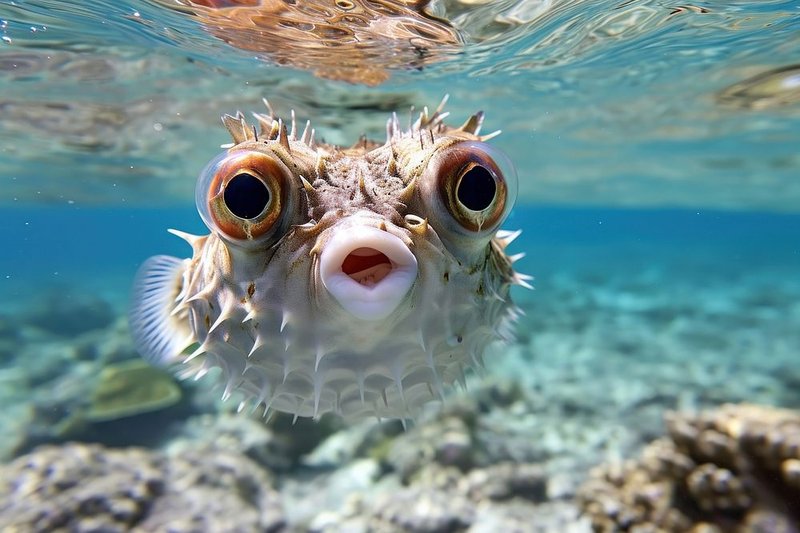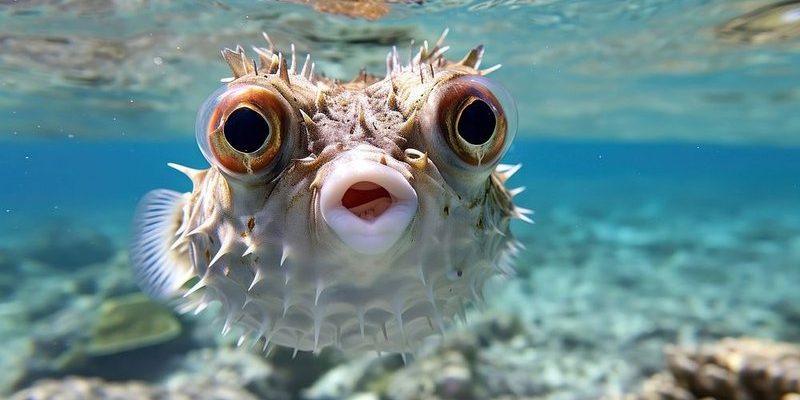
So, what exactly makes the pufferfish so special? Here’s the thing: their adaptations are not just for show. These features help them evade predators, find food, and even survive in less-than-ideal water conditions. Let’s dive in and explore the remarkable adaptations that help these fish navigate their watery world with style and skill.
1. The Puffing Mechanism
One of the pufferfish’s most famous traits is its ability to puff up. This process isn’t just a party trick; it serves a crucial purpose. When threatened, the pufferfish can swallow water (or air) and expand its body to several times its normal size. This sudden increase in size can deter potential predators, as a larger, spiky fish is less appealing as a meal.
But how does this actually work? The pufferfish has a specialized stomach that stretches and can hold large amounts of water. Once inflated, the fish’s spines also stand out, making it even less attractive to predators. Honestly, it’s like wearing a suit of armor! You might be wondering if this process is stressful for the pufferfish, and while it requires energy, it’s a vital survival tactic.
2. Toxicity: Nature’s Defense System
Pufferfish aren’t just tough; they’re also toxic. Many species carry a potent neurotoxin called tetrodotoxin, which can be deadly to predators and even humans. The reason for this toxicity is simple—it’s an effective deterrent. If a predator takes a bite and gets a taste of that toxin, they quickly learn to avoid pufferfish in the future.
You might think, “How does the pufferfish produce this toxin?” Well, they don’t actually create it themselves. Instead, they accumulate it from their diet, mainly from certain marine bacteria and sea creatures. This is an example of something called symbiosis, which is a fancy word for when different species work together for mutual benefit. It’s like having a great roommate when you’re in college, helping each other out!
3. Camouflaging Skills
Another impressive adaptation is the pufferfish’s ability to blend into its surroundings. Just like some people can wear a color that makes them pop at a party, pufferfish can use their skin to blend into the ocean floor, hiding from predators. Their skin can change color and texture, helping them to escape notice.
This form of camouflage is particularly useful in habitats like coral reefs, where many colors and patterns abound. By taking advantage of their environment, pufferfish can avoid predators and find food without drawing attention to themselves. Imagine trying to play hide-and-seek in a room full of furniture; you’d want to be the same color as that sofa for the best chance of winning!
4. Flexible Diet and Feeding Habits
Let’s chat about food. Pufferfish are omnivores, which means they eat both plants and animals. Their sharp beak-like teeth are perfect for cracking open hard-shelled prey like shellfish and crustaceans. This adaptability gives them a significant advantage in the wild.
They also have a knack for foraging. Pufferfish can scavenge through the ocean floor for food, which allows them to thrive even in environments where food might be scarce. It’s a bit like being a smart shopper—knowing where to find goodies when times are tough. And since their diet includes a variety of items, they can switch things up based on what’s available.
5. Social Behavior and Mating Rituals
Pufferfish might be solitary, but they’ve got some interesting social behaviors, especially when it comes to mating. During the breeding season, male pufferfish are known for creating elaborate nests in the sand. They use their fins to create intricate patterns that attract females.
These patterns aren’t just visually appealing; they also demonstrate the male’s health and vitality. It’s like a dating profile but under the sea! After the female lays her eggs, the male fertilizes them and stays close, guarding the nest from potential threats. This commitment to parenting isn’t common in the fish world but shows another layer of pufferfish adaptation.
6. Resilience to Environmental Changes
Pufferfish are surprisingly resilient. They can survive in various habitats, from coastal lagoons to deep ocean waters. Their adaptability means they can thrive in environments that many fish can’t handle, like waters with varying salinity levels or temperature changes.
This resilience is key, especially in a world where climate change and pollution are affecting marine ecosystems. By being able to tolerate these changes, pufferfish increase their chances of survival. It’s a bit like being a versatile athlete who can play multiple sports—more opportunities to shine!
7. Special Senses
To navigate their often murky underwater world, pufferfish have developed excellent senses. They possess keen eyesight, which helps them spot food and predators from a distance. Their sense of smell is also highly developed, allowing them to detect food sources and potential threats.
Imagine walking through a dark room—wouldn’t it be handy to have super senses to help you navigate? For pufferfish, these adaptations make it easier to thrive in environments where visibility might not be great. Their senses are not just tools; they are lifelines in the ocean’s vast expanse.
Pufferfish are more than just cute and quirky; they are a testament to the power of adaptation in nature. From their impressive puffing ability to their clever use of camouflage and their unique diets, these fish are remarkable survivors. In a world where so many species face challenges, pufferfish show us that creativity and resilience can lead to thriving even in the deepest parts of the ocean.
So, the next time you think about aquatic life, remember the pufferfish. Their adaptations remind us that survival often requires a blend of ingenuity and flexibility. Whether they’re puffing up or employing a deadly defense, these creatures are a perfect example of how life finds a way to thrive.

